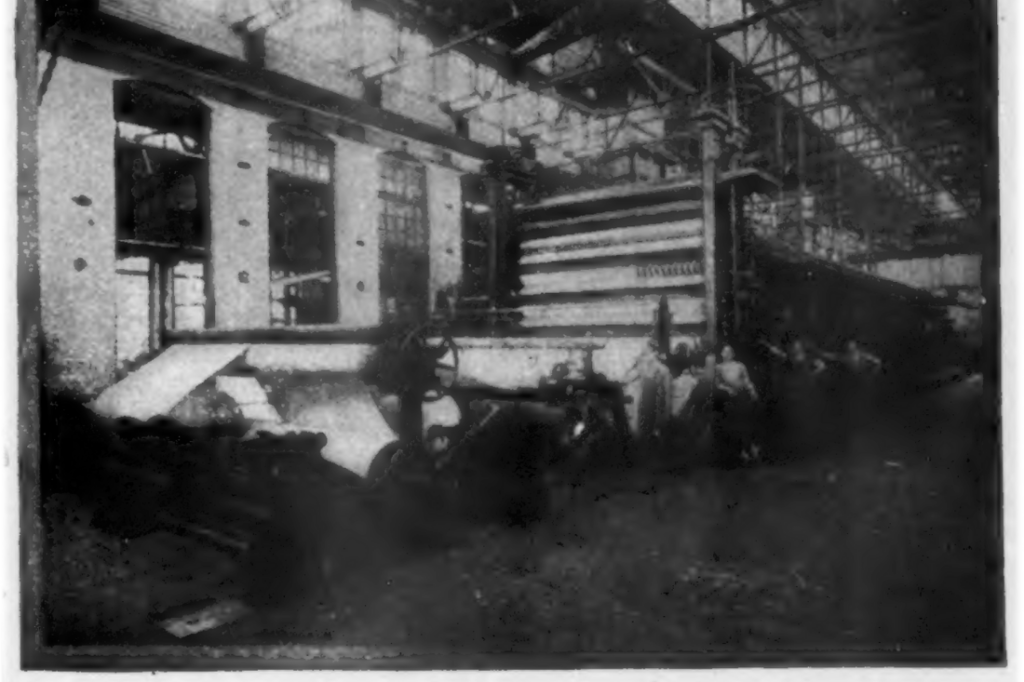As you open a great metropolitan daily to learn what the world was doing yesterday, it may not occur to you that the paper on which the newspaper is printed was, but a few days ago, the living fiber of the spruce trees of some northern forest.
Tear off a corner of a page, examining the ragged edges closely, and you will see that the paper is made of short, hairlike fibers, which you can pull out, as you would lint from a cotton plant or the finer threads of a linen handkerchief. Examine a sliver of wood, and you will detect the same hairlike fibers. Vegetable fibers are the basis of the manufacture of all ordinary fabrics; but, within a few years, on account of the enormous demand for newspapers in America, the making of paper from vegetable fiber has outstripped all similar industries. The Fourdrinier machine, now a century old, revolutionized paper-making. Without it, and without, too, American wood pulp processes, the cheap newspaper and the cheap book of today would be impossible. No one can estimate the good that cheap printing paper has done for mankind.
The owners of New York City newspapers guard closely their circulation secrets; and, consequently, papermakers will not let the public know how much white paper they supply to the different offices…
At $40 a ton, 135,000 tons of paper cost the newspapers of New York City $5,400,000. This is a daily consumption of about 375 tons, costing $15,000. Of this sum, William R. Hearst, proprietor of the Journal, pays $4,000; Joseph Pulitzer, proprietor of the World, more than $3,000; and James Gordon Bennett, proprietor of the Herald, more than $2,500. In other words, Mr. Hearst cannot pay his bill for white paper until he has sold 800,000 Journals, which shows that publishing a great newspaper in New York City, or any other large city, is a serious financial undertaking. It is not every man that has the courage to face a bill of several thousand dollars for blank paper alone every time the sun rises.
A 1-cent morning newspaper cannot pay its white-paper bills from its sales of papers. It is no difficult matter to make some very interesting estimates from the data the papermakers furnish. For example, the rolls of paper that are poured into the big offices in Printing House Square, New York City, cost $20 each, and contain five miles of paper, or enough to print 9,000 12-page papers. The New York Journal, Herald and World print about 200 pages a week, each, averaging 18 pages on weekdays and 90 pages on Sunday; that is, a $20 roll of paper will print 540 copies of the Journal for a week, for which Mr. Hearst receives between $35 and $40. One hundred and thirty-five thousand tons of paper, used yearly by the New York City newspapers, is equivalent to 270,000 five-mile rolls, or 1,350,000 miles of paper, not far from 4,000 miles a day—enough to stretch across the continent and dip into both oceans.
Without the enormous receipts from advertising, a great newspaper could be published only at a huge loss. The white-paper bills would bankrupt any man who should attempt to print a newspaper without advertisements. Mr. Bennett receives from the advertising in the Herald, which runs over 600 columns a week, more than $3 million a year. The greater part of this sum is expended for paper and editorial, business and mechanical expenses; but, by selling the Herald at 3 cents a copy, he makes it one of the best-paying newspaper properties in the world.
Nearly every copy of the massive, metropolitan newspapers is thrown away after it has been read, as it is regarded then as waste, worthless paper. Mr. Bennett, however, when he buys his of the papermaker, takes a very different view of the value of the white paper on which he spreads the news; for, at the end of the year, when he receives the Herald’s balance sheet, he finds that his white paper has cost him $1 million. His great rival, Mr. Hearst, has a still larger bill for paper. Scores of half-ton rolls from the Adirondack forests are fed to his presses every day, from midnight to midnight, and his outlay for paper, in the course of a year, amounts to about $1,600,000.
In Printing House Square, within the shadow of the statue of Benjamin Franklin, who turned the first hand-press in America, more white paper is fed to the steel monsters, thundering in the caverns below, than is used on any other spot on the globe. Printing House Square, the newspaper center of the world, is the basis of a great industry that has grown up in recent years in this country—that of making paper from timber. American newspapers use a quarter of the entire American production of paper of all kinds, and our output is a quarter of that of the whole world. The American people are truly illustrative of the adage, “The consumption of paper is the measure of a people’s culture.”
This excerpted article was originally published in a 1902 issue of SUCCESS magazine, and recently appeared in the January/February 2023 issue.





